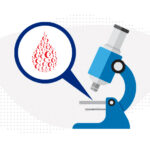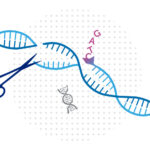A sickle cell first: Base editing, a new form of gene therapy, leaves Branden feeling ‘more than fine’

Though he doesn’t remember it, Branden Baptiste had his first sickle cell crisis at age 2. Through elementary school, he was in and out of the hospital with pain episodes, not knowing why. As he got older, he learned he had sickle cell disease. His red blood cells were forming sickle shapes and getting stuck in his blood stream, preventing oxygen from reaching his tissues.
“From age 12, things skyrocketed,” says Branden, now 20. “I was in the hospital every other month with crises.” He estimates he missed 60 days of school every year.
In sixth grade, Branden had to have his left hip replaced because of damage to his hip joint, another complication of his illness. His right hip was replaced not long after. In 2020, at age 17, he suffered a life-threatening complication: acute chest syndrome, or ACS. Branden’s sickled cells were clumping and blocking blood vessels in his lungs. Terrified, he called an ambulance.
“I thought everything was over. I couldn’t breathe. If I inhaled a little bit, it felt like something was stabbing my lung,” Branden recalls. Four more ACS episodes struck that year, causing Branden to miss his entire junior year of high school. The worst episode landed him in the intensive care unit.
“Sickle cell disease has a broad spectrum of severity, and the severity and frequency of complications can wax and wane,” says Matthew Heeney, MD, Branden’s long-time hematologist at Boston Children’s Hospital. “Unfortunately, Branden was quickly acquiring many of the chronic complications of sickle cell disease, including organ dysfunction affecting his kidneys, lungs, joints, and eyes.”
Choosing base editing gene therapy
Around that time, potentially curative gene therapies for sickle cell disease were becoming available. Heeney, then director of Boston Children’s Sickle Cell Disease Program, offered Branden the option of enrolling in a new clinical trial called BEACON, led at Boston Children’s by Heeney and sponsored by Beam Therapeutics. The trial is testing base editing — the most precise form of gene therapy yet developed — as a way to boost production of a fetal form of hemoglobin, which unlike “adult” hemoglobin does not cause sickling.
Unlike conventional gene editing strategies that create a cut or break in the double strand of DNA, base editing uses enzymes to correct a single misspelled “letter” of a gene. (See this video to learn more.) Branden would be the first person in the world to receive base editing for sickle cell disease, and among the first to receive it for any condition.
Branden agreed to take the gamble. His symptoms, especially ACS, had become unbearable. He wanted them gone so he could get on with life.
“I was like, ‘Why am I still in high school? By this time I should be a sophomore in college,’” he says.
A journey with many steps
Over the course of 2023, Branden came to Boston Children’s for a series of tests to ensure he could withstand the rigors of gene therapy treatment. By October 2023, he was ready. The first step was to collect blood stem cells from his blood, which required two several-day stays at Boston Children’s. The precious stem cells then went to a special facility to undergo base editing treatment.
But before Branden could receive his base-edited cells, he needed chemotherapy to kill the diseased blood stem cells in his bone marrow and make room for the treated cells. He was readmitted to Boston Children’s in late November 2023 and infused with his genetically treated cells on December 5.

The next step was to wait for the treated cells to settle into Branden’s bone marrow and start producing blood cells. This kept him in the hospital for several more weeks.
“I was fine. I was bored,” Branden says. “I was waiting for my blood to build back.” When his mom, brother, sister, girlfriend, and girlfriend’s family weren’t keeping him company, he passed the time with his PlayStation and watching all eight seasons of the Netflix drama Suits.
“The nurses were super nice to me and treated me like a friend,” he says. “Everyone in the Stem Cell Transplant clinic was mad nice and super funny.”
‘I’m operating in every way possible’
Branden surprised and delighted his family by arriving home on Christmas Eve — well ahead of schedule.
“Everyone was like, ‘What?’” he says. “Initially, I was told I would be in the hospital for two months, and then I got out in 20 days. Everyone was shocked, even the doctors were shocked.”
Branden has felt good ever since his infusion and says he’s off all his sickle cell medication. “In my opinion, I’m perfect. I never felt fine before — before, ‘fine’ was moderate pain I could take deep breaths through. Now I’m more than fine. I’m operating in every way possible.”
He finished high school in January and plans to attend college for study civil engineering. Until then, he plans to work and recently got a job at the Transportation Security Administration (TSA) as an airport security officer.
“I feel good enough to work there,” Branden says. “I never worked a serious job before because of how much I was in the hospital.”
Another big change in Branden’s life: he can now exercise. “I used to always try to exercise, but every little movement would cause joint pain, and exhaustion would also cause pain,” he says. “Now I’m going to the gym every day, doing cardio and weight lifting.”
Promising early trial results
Branden will be monitored closely by Boston Children’s Gene Therapy Program for the next 15 years. Meanwhile, the BEACON trial is still continuing. Early findings are encouraging: In an initial group of treated patients, base editing appeared safe, boosted fetal hemoglobin levels, and improved anemia. Heeney presented these results December 8 at the American Society of Hematology Annual Meeting in San Diego.
“The treatment has been truly transformative for Branden,” Heeney says. “Not only are his blood counts and markers of disease activity essentially normalized, but he can now complete daily activities that most take for granted and tackle new experiences previously beyond his reach. It is a joy to see him setting goals that seemed unfathomable just a year or two ago.”
Disclosure: Matthew Heeney, MD has received financial compensation as a consultant for Beam Therapeutics.
Learn more about sickle cell disease and gene therapy options at Boston Children’s.
Related Posts :
-

Sickle cell gene therapy and boosting fetal hemoglobin: A 75-year history
Ed. Note: This post updates an earlier post from 2018. In a landmark decision today, the Food and Drug Administration (FDA) ...
-

Gene therapy’s future may be all about the bases
Gene therapy offers the possibility of a cure for many genetic disorders, especially those involving a single gene. The first ...
-

A potential danger of CRISPR gene editing — and why base editing may be safer
Gene therapy using CRISPR/Cas9 gene editing is currently in clinical trials around the world for a variety of diseases, ...
-

After decades of evolution, gene therapy arrives
As early as the 1960s, scientists speculated that DNA sequences could be introduced into patients’ cells to cure genetic disorders. ...





